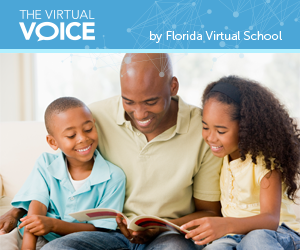Cows, Hens, and Ducks…OH MY!
 The Importance of Children’s Picture Books in Kindergarten—Grade 12
The Importance of Children’s Picture Books in Kindergarten—Grade 12
“Once upon a time…”
I always get chills when I read these first few words contained in many children’s books. The words bring me back to a simpler time when reading was filled with colorful illustrations, playful words, and the promise of happily ever after.
My daughters, ages 7 and 10, are voracious readers and they moved quickly from picture books to chapter books by first grade. While I would delight in their accomplishment of reading books like The Magic Treehouse, it worried me that they might not recall the joys of reading books that could tell a story in both illustrations and words. Our weekly trips to the public library to check out books no longer included time in the children’s reading room, but instead we sat on the floor in the juvenile fiction section looking for books by Sunshine State Nominees and Newberry Award winners for excellence in writing. Would my children ever remember the Caldecott-awarded picture books of their childhood and the beauty the books possess?
Did you know that children’s literature covers topics such as history/political science, building and maintaining relationships, coping strategies, and even retells the literary classics? That you can help children understand the complexities of the human experience all from reading a picture book? One of my favorite books teaches children about social injustice and the conceptual foundation for civil rights/animal rights, Click, Clack, Moo: Cows That Type, by Doreen Cronin:
“The animals in Farmer Brown’s barn are unhappy with the way they are being treated. All day long they post typewritten notes to Farmer Brown, demanding better working conditions. Ultimately, the cows and hens threaten to go on strike. ‘Click, Clack, Moo,’ a Caldecott Honor book, is a humorous and thought-provoking analogy that demonstrates the importance of taking action in the face of injustice.” [1]
This is what you get when you have a trained lawyer write a children’s book.
Reading picture books such as Click, Clack Moo: Cows That Type at the different grade levels will solicit a wide spectrum of responses based on prior knowledge. Looking at the ever-changing landscape of educational standards children are being asked to master at a young age, picture books open doors to deep discussion with the support of rich, meaningful text. Parents and teachers can pull a variety of topics from this beautifully-illustrated and cleverly-written book such as life on a farm, fiction vs. non-fiction, and fairness. Click, Clack Moo: Cows That Type is a second grade level picture book, but with the import of higher level vocabulary words in the story such as: compromise, negotiate, improve, and strike; students can begin to explore historical/current events and dare I say even maybe cultivate some interesting dinner time conversation with children of a variety of ages.
I used Doreen Cronin’s book as it is one of my daughters’ favorite books to read both independently and as a read-aloud. When they were preschoolers it was a silly story about farm animals who wanted to use electric blankets in the barn to keep warm at night. As the girls grew it morphed into a parable and became a lesson in communication, negotiating, conflict resolution, and passive resistance.
Who knew?
Resources
[1] http://education.miami.edu/legacyproject/documents/ClickClackMoo.pdf

 Dr. Jeanne Giardino, FLVS instructor, has a true passion for all things literacy. She enjoys the collaborative process in promoting reading in all aspects of virtual education. Having held a variety of positions with FLVS since 2006, she brings a global perspective to her current position. After 20 years in the field of education, she maintains a wealth of literacy knowledge and enthusiasm for student success.
Dr. Jeanne Giardino, FLVS instructor, has a true passion for all things literacy. She enjoys the collaborative process in promoting reading in all aspects of virtual education. Having held a variety of positions with FLVS since 2006, she brings a global perspective to her current position. After 20 years in the field of education, she maintains a wealth of literacy knowledge and enthusiasm for student success.